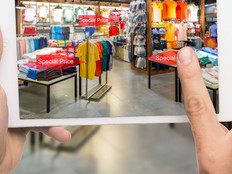Retailers Need Strong Networks to Support the Future of In-Store Tech
As retail continues to evolve, many stores are focusing on the customer experience across channels and the rapidly changing behaviors of consumers themselves. While electronic commerce is growing in popularity, many retailers are renewing their emphasis on the in-store experience.
To accommodate this shift, as well as to provide the flexibility to take advantage of opportunities that lie ahead, retailers need a robust wireless and wired network infrastructure.
Not only must their networks meet today’s demands, they also need the kind of next-generation components and capabilities that help future-proof their infrastructure.
“Consumer behaviors and other factors impacting retail store systems have drastically changed in recent years,” says David Herzig, channel manager for retail solutions at HP.
For one thing, he says, more than 90 percent of consumers use technology, such as mobile devices and apps, when they shop. Networks that have been used to support limited store functions, such as point-of-sale systems, must now provide the connected consumer with Wi-Fi access, as well as support several other touchpoints and systems to deliver a better experience and help retailers optimize operations.
“Next-generation networks need to support new in-store behaviors, systems and touchpoints,” says Herzig. “These include mobility, digital signage, self-service kiosks, radio frequency ID [RFID], beacons and ‘endless aisle’ capabilities.”
SIGN UP: Get more news from the BizTech newsletter in your inbox every two weeks!
Wireless Networks Are Critical to the Customer Experience
In-store wireless is critical for more than customer engagement and satisfaction. To leverage all the potentially valuable data generated by the Internet of Things (IoT), retail IT departments must manage and support a robust wireless network to connect sensors and other data sources.
These include RFID tags that monitor in-store stock and connect to key systems in the retailer’s data center to enable inventory and supply-chain optimization. Retailers also must support mobile point-of-sale systems, which help store associates access up-to-date customer information from key back-end data sources so they can provide better service and process payments anywhere in the store.
Stores can further boost customer satisfaction by using wirelessly connected Bluetooth beacons, taking advantage of geolocation technologies to send personalized messages to a customer’s smartphone when they enter a store, alerting them to promotions or delivering digital coupons tailored to their needs.
“There’s so much you can do if you have in-store wireless,” says Paula Rosenblum, a retail technology research analyst with Retail Systems Research. However, based on RSR’s 2015 research, about half of retailers haven’t yet implemented it on the store floor.
With Wi-Fi, she adds, “It’s not about staying ahead of your competitors — it’s about keeping up with your customers.” A store’s wireless network is also a critical tool for managers and sales associates.
Managers, says Rosenblum, shouldn’t have to make a tough choice of whether to stay on the floor to monitor customer and employee activity or to sit in an office to access important information on a desktop computer. With wireless in place, they don’t have to decide: They can view exception reports, problem reports and sales reports on their mobile devices and still pay attention to customers and associates, all while moving around the store.
Software-Defined Networking Gives Retailers Flexibility
According to Herzig, nearly 60 percent of retailers rate mobility solutions as their leading customer engagement priority. However, they worry that compliance with the Payment Card Industry data security standard and data security in general will become even more challenging if they implement in-store wireless. A robust and secure network infrastructure, both wireless and wired, is of paramount importance.
Software-defined networking (SDN) helps retailers address their security and compliance concerns by extending data center policies to their stores, but that’s just the beginning of what it brings to the table.
By decoupling a network’s control plane from its data plane, abstracting the underlying architecture, SDN allows administrators to program control functions, making them much more agile and adaptable in their deployment and management of applications and network services.
A next-generation SDN architecture also enables centralized, unified network management of both wired and wireless networks, providing IT teams better visibility into connected devices, traffic, resource usage and application performance.
As retailers grow, implement IoT solutions and take advantage of advanced analytics that pull from internal and cloud data sources, they’ll need SDN’s flexibility so they can more easily configure their networks, as well as scale, increase bandwidth and easily connect to cloud services.
Retailers will rely on SDN and high-performance networks to better engage customers via various technologies, says Herzig. As brand messaging through digital media becomes commonplace, network connectivity requirements have increased dramatically.
“Store signage that took weeks to implement can now be updated instantly over the network,” he adds. “Retailers are also depending on next-generation network connectivity to access analytics data, [Human Resources] information, training systems, and employee and consumer engagement tools.”
Technology providers are continually rolling out next-generation networking solutions and retail-related applications that leverage them.
For stores that already have video surveillance or are deploying it, for instance, Cisco Systems offers analytics technology “so retailers can just jack into those feeds and use pattern matching, facial recognition and other capabilities,” says Brad Shimmin, service director for business technology and software at research firm Current Analysis. Further, this and other new offerings are leveraging sophisticated network and processing technologies to crunch data at the edge of the network so retailers can get the insight they need close to the decision point.
“This is an entirely new world for retailers,” says Shimmin.
For more on how you can take advantage of retail technology solutions, visit CDW.com/retail.








